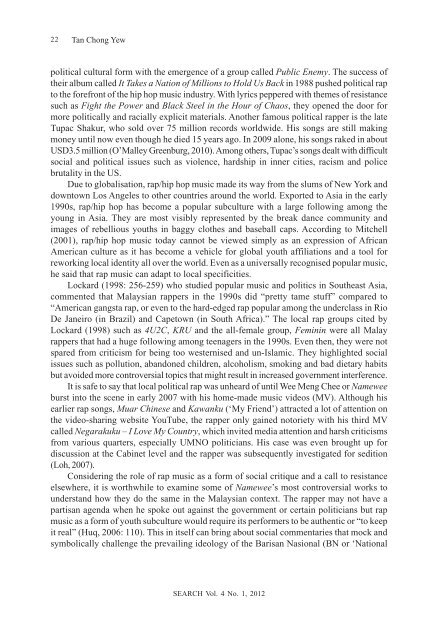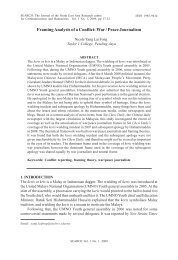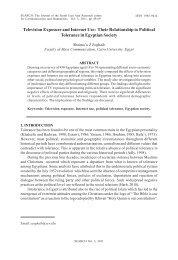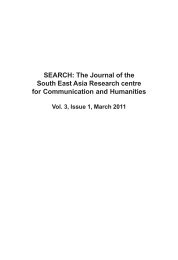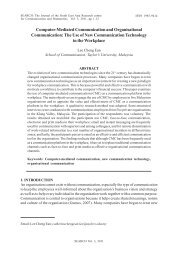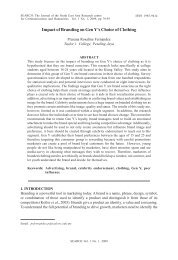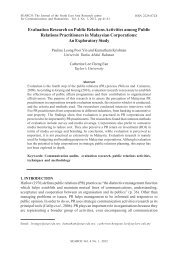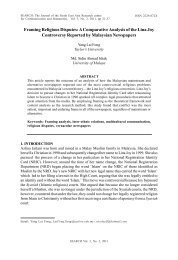Hegemony and Symbolic Resistance in Malaysia - South East Asia ...
Hegemony and Symbolic Resistance in Malaysia - South East Asia ...
Hegemony and Symbolic Resistance in Malaysia - South East Asia ...
You also want an ePaper? Increase the reach of your titles
YUMPU automatically turns print PDFs into web optimized ePapers that Google loves.
22<br />
Tan Chong Yew<br />
political cultural form with the emergence of a group called Public Enemy. The success of<br />
their album called It Takes a Nation of Millions to Hold Us Back <strong>in</strong> 1988 pushed political rap<br />
to the forefront of the hip hop music <strong>in</strong>dustry. With lyrics peppered with themes of resistance<br />
such as Fight the Power <strong>and</strong> Black Steel <strong>in</strong> the Hour of Chaos, they opened the door for<br />
more politically <strong>and</strong> racially explicit materials. Another famous political rapper is the late<br />
Tupac Shakur, who sold over 75 million records worldwide. His songs are still mak<strong>in</strong>g<br />
money until now even though he died 15 years ago. In 2009 alone, his songs raked <strong>in</strong> about<br />
USD3.5 million (O’Malley Greenburg, 2010). Among others, Tupac’s songs dealt with difficult<br />
social <strong>and</strong> political issues such as violence, hardship <strong>in</strong> <strong>in</strong>ner cities, racism <strong>and</strong> police<br />
brutality <strong>in</strong> the US.<br />
Due to globalisation, rap/hip hop music made its way from the slums of New York <strong>and</strong><br />
downtown Los Angeles to other countries around the world. Exported to <strong>Asia</strong> <strong>in</strong> the early<br />
1990s, rap/hip hop has become a popular subculture with a large follow<strong>in</strong>g among the<br />
young <strong>in</strong> <strong>Asia</strong>. They are most visibly represented by the break dance community <strong>and</strong><br />
images of rebellious youths <strong>in</strong> baggy clothes <strong>and</strong> baseball caps. Accord<strong>in</strong>g to Mitchell<br />
(2001), rap/hip hop music today cannot be viewed simply as an expression of African<br />
American culture as it has become a vehicle for global youth affiliations <strong>and</strong> a tool for<br />
rework<strong>in</strong>g local identity all over the world. Even as a universally recognised popular music,<br />
he said that rap music can adapt to local specificities.<br />
Lockard (1998: 256-259) who studied popular music <strong>and</strong> politics <strong>in</strong> <strong>South</strong>east <strong>Asia</strong>,<br />
commented that <strong>Malaysia</strong>n rappers <strong>in</strong> the 1990s did “pretty tame stuff” compared to<br />
“American gangsta rap, or even to the hard-edged rap popular among the underclass <strong>in</strong> Rio<br />
De Janeiro (<strong>in</strong> Brazil) <strong>and</strong> Capetown (<strong>in</strong> <strong>South</strong> Africa).” The local rap groups cited by<br />
Lockard (1998) such as 4U2C, KRU <strong>and</strong> the all-female group, Fem<strong>in</strong><strong>in</strong> were all Malay<br />
rappers that had a huge follow<strong>in</strong>g among teenagers <strong>in</strong> the 1990s. Even then, they were not<br />
spared from criticism for be<strong>in</strong>g too westernised <strong>and</strong> un-Islamic. They highlighted social<br />
issues such as pollution, ab<strong>and</strong>oned children, alcoholism, smok<strong>in</strong>g <strong>and</strong> bad dietary habits<br />
but avoided more controversial topics that might result <strong>in</strong> <strong>in</strong>creased government <strong>in</strong>terference.<br />
It is safe to say that local political rap was unheard of until Wee Meng Chee or Namewee<br />
burst <strong>in</strong>to the scene <strong>in</strong> early 2007 with his home-made music videos (MV). Although his<br />
earlier rap songs, Muar Ch<strong>in</strong>ese <strong>and</strong> Kawanku (‘My Friend’) attracted a lot of attention on<br />
the video-shar<strong>in</strong>g website YouTube, the rapper only ga<strong>in</strong>ed notoriety with his third MV<br />
called Negarakuku – I Love My Country, which <strong>in</strong>vited media attention <strong>and</strong> harsh criticisms<br />
from various quarters, especially UMNO politicians. His case was even brought up for<br />
discussion at the Cab<strong>in</strong>et level <strong>and</strong> the rapper was subsequently <strong>in</strong>vestigated for sedition<br />
(Loh, 2007).<br />
Consider<strong>in</strong>g the role of rap music as a form of social critique <strong>and</strong> a call to resistance<br />
elsewhere, it is worthwhile to exam<strong>in</strong>e some of Namewee’s most controversial works to<br />
underst<strong>and</strong> how they do the same <strong>in</strong> the <strong>Malaysia</strong>n context. The rapper may not have a<br />
partisan agenda when he spoke out aga<strong>in</strong>st the government or certa<strong>in</strong> politicians but rap<br />
music as a form of youth subculture would require its performers to be authentic or “to keep<br />
it real” (Huq, 2006: 110). This <strong>in</strong> itself can br<strong>in</strong>g about social commentaries that mock <strong>and</strong><br />
symbolically challenge the prevail<strong>in</strong>g ideology of the Barisan Nasional (BN or ‘National<br />
SEARCH Vol. 4 No. 1, 2012


